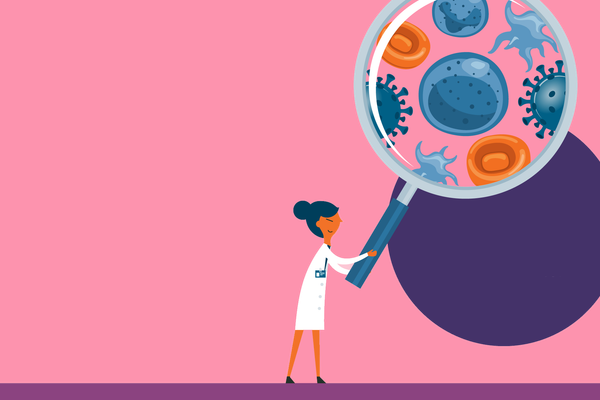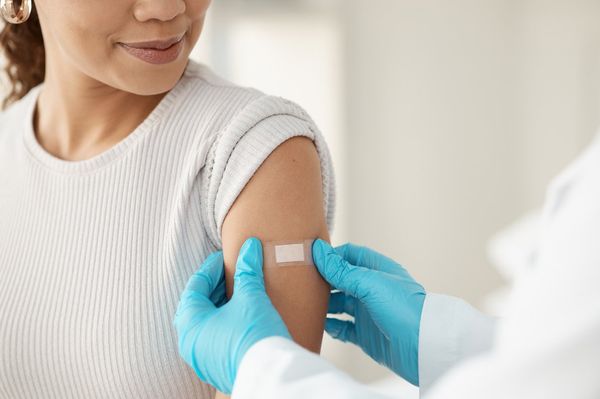Video/Image | Voiceover/Audio | |
Drawing of woman lying in a hospital bed erased and replaced with drawing of a syringe | Many formerly common diseases are now under control, thanks to vaccines. Let’s look at some of these diseases — and the vaccines that prevent them. | |
Drawing of the word “Polio” erased and replaced by a drawing of a skeleton and an arrow pointing to the spine | Polio is caused by the poliovirus, and it can affect the spinal cord, causing paralysis. | |
Drawing of 10 stick figures: 9 are black and 1 is red. | Up to 1 out of 10 of people with polio who are paralyzed die because the virus affects the muscles that help them breathe. | |
Drawing of people waiting in line at the grocery store with 1 person coughing on another person in line | Polio is highly contagious, meaning it can easily spread from person to person. | |
Drawing of a mother holding a toddler on her lap while a nurse gives the toddler an injection in the upper thigh | But it can be prevented with a vaccine that is given to children in 4 doses. | |
Drawing of the word “Measles” erased and replaced by a child in a hospital bed | Measles is also a highly contagious infection spread by a virus that can cause serious health problems, especially in young children. About 1 in 5 people who get measles in the United States need to be hospitalized. | |
Drawing of a coughing person surrounded by 10 other people. 9 out of the 10 surrounding people start coughing, too | Measles is spread through coughing and sneezing. It’s so contagious that if one person has it, up to 9 out of 10 people around them will also get it. | |
Drawing of words “Measles-mumps-rubella” followed by “ MMR” Drawing of syringe labeled “MMR” and the words mumps and rubella | Measles is prevented with the Measles-mumps-rubella vaccine, also known as the MMR, which also protects against two other diseases as well — mumps and rubella. | |
Drawing of word “Mumps” erased and replaced by a drawing of a child with puffy cheeks and a thermometer in their mouth | Mumps is a contagious disease caused by a virus. It’s known for causing puffy cheeks that come from having swollen glands. | |
Drawing of adult in hospital bed | This disease is usually mild in kids, but can cause serious problems for adults. | |
Drawing of words “Rubella also known as German measles” | The third disease prevented by the MMR vaccine is rubella, which is also called the German measles. | |
Drawing of pregnant woman | Rubella is also caused by a virus and is usually mild — but can cause a miscarriage or birth defects if a woman is infected during pregnancy. | |
Drawing of these words: DTaP = diphtheria, tetanus and pertussis Tdap = tetanus, diphtheria and pertussis | Other common vaccines called DTaP and Tdap are used to prevent multiple diseases. They both cover diphtheria, tetanus and pertussis – but they are different doses because one is for babies and young children and the other is for older children, teens and adults. | |
Drawing of words 3+2 = 5 total doses for babies and children | Babies need three doses of the DTaP vaccine and young children need two DTaP booster shots. | |
Drawing of boost immunity | Older kids and adults get the Tdap vaccine to boost immunity. | |
Drawing of the word “Diphtheria” | Diphtheria is a contagious infection caused by bacteria that can lead to trouble breathing, heart problems and even death. | |
Drawing of word Tetanus | Another disease prevented by the DTaP and Tdap vaccines is tetanus. This bacterial infection produces a toxin in the body that causes painful muscle contractions. | |
Drawing of person’s head in profile with arrow pointing to the jaw | Tetanus is also called “lockjaw” because it often causes the neck and jaw muscles to tighten, making it hard to open your mouth or swallow. | |
Drawing of 10 stick figures: 8 are black and 2 are red | Tetanus can cause serious health problems and, even, death. Up to 2 in 10 people with tetanus will die. | |
Drawing of words Pertussis also known as whooping cough erased and then drawing of a person coughing | Pertussis is the third disease prevented by the DTaP and Tdap vaccines. Also known as whooping cough, pertussis is a highly contagious respiratory disease caused by bacteria. | |
Drawing of words dangerous in babies | It can affect people of all ages but is most dangerous for babies. | |
Drawing of word Rotavirus | The final vaccine-preventable disease we’re going to look at today is rotavirus, which is very contagious and often affects babies and young children. | |
| Rotavirus is serious and can lead to both hospitalization and death. | |
Drawing of words RotaTeq and Rotarix | There are two vaccines available in the U.S. that help prevent rotavirus. They’re called RotaTeq and Rotarix. | |
Drawing of woman holding baby in her arms while nurse puts drops in the baby’s mouth | Both rotavirus vaccines are given to babies in two or three oral doses. | |
Drawing of words 51,000,000 | The most important thing to remember about all of these diseases is that, while they are under control, they haven’t gone away. But 51 million deaths can be prevented through immunization between 2021 and 2030. | |
Drawing of a smiling pharmacist behind a counter with a sign reading “Vaccines available here” on it | Vaccines are one of the safest and easiest ways to protect yourself and your family. In addition to a healthcare provider’s office, many vaccines are available at your local pharmacy or public health department. Talk to your provider about what vaccines you need to be up to date! | |
For more information, please visit HealthyWomen.org | ||
This resource was created with support from Merck. | ||
- What You Need to Know About Viral Hepatitis ›
- I Was a Polio Pioneer, and I Can’t Wait to Get the COVID-19 Vaccine ›
- The Dark Days Before Vaccines ›
- 10 Vaccines Adults Should Get ›
- Understanding the Different Types of Covid-19 Vaccines ›
- Vaccine Education Program ›







